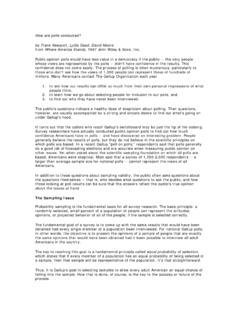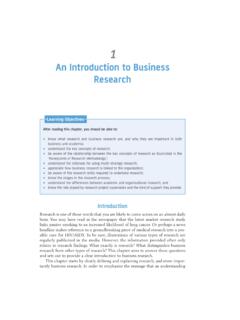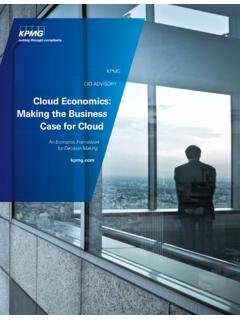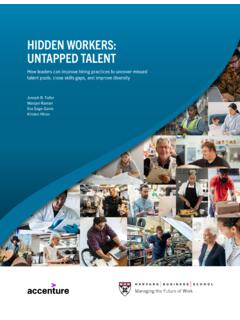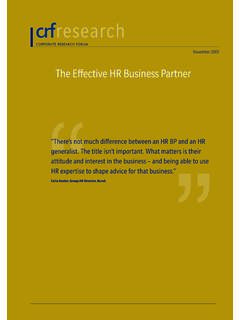Transcription of WELL-BEING IN THE WORKPLACE AND ITS RELATIONSHIP TO ...
1 WELL-BEING IN THE WORKPLACE . AND ITS RELATIONSHIP TO. business OUTCOMES. A REVIEW OF THE GALLUP. STUDIES. James K. Harter, Frank L. Schmidt, and Corey L. M. Keyes CREDITS. The text in this document was originally published in Flourishing: The Positive Person and the Good Life (Chapter 9, pp. 205-224), edited by Corey L. M. Keyes and Jonathan Haidt, and published by the American Psychological Association in November, 2003. In Flourishing, the editors present a rationale for studying fulfillment, morality, and other factors that make life worthwhile.
2 Flourishing is a collection of articles taken from the proceedings of the first Summit of Positive Psychology, held by The Gallup Organization in Lincoln, NE, on September 9-12,1999. AMERICAN PSYCHOLOGICAL ASSOCIATION COPYRIGHTS. Flourishing: The Positive Person and the Good Life as well as WELL-BEING in the WORKPLACE and its RELATIONSHIP to business Outcomes: A Review of the Gallup Studies (Chapter 9, pp. 205- 224), is copyrighted by the American Psychological Association, Washington All rights reserved. GALLUP COPYRIGHTS AND TRADEMARKS.
3 This document contains proprietary research , copyrighted material, and literary property of The Gallup Organization. It is not to be copied, quoted, or reproduced without the expressed written permission of The Gallup Organization. Gallup , Q12 , and StrengthsFinder , are trademarks of The Gallup Organization, Princeton, WELL-BEING IN THE WORKPLACE AND ITS RELATIONSHIP TO. business OUTCOMES: A REVIEW OF THE GALLUP STUDIES. James K. Harter, Frank L. Schmidt, and Corey L. M. Keyes Two lines of research characterize the study of the effects of organizational environment on workers' quality of life and performance.
4 The first line originates with the study of stress and health and is best represented by the theory of person--environment fit (see French, Caplan, & Van Harrison, 1982). Proponents of the stress perspective argue that worker performance and quality of life are hindered by strain (too much challenge) or boredom (too little challenge). When demands exceed or fall below the resources, individuals experience undesirable states ( , strain or boredom) that hinder the quality and quantity of performance as well as their WELL-BEING .
5 From the stress perspective, a healthy work force means the absence of strain or boredom (see also Edwards, Caplan, & Van Harrison, 1998). A second line of research on worker quality of life and performance originates with the behavioral, cognitive, and health benefits of positive feelings and positive perceptions (Isen, 1987; Warr, 1999). Proponents of the WELL-BEING perspective argue that the presence of positive emotional states and positive appraisals of the worker and his or her relationships within the WORKPLACE accentuate worker performance and quality of life.
6 When environments provide and people seek out interesting, meaningful, and challenging tasks, individuals in these situations are likely to have what Brim (1992) has called manageable difficulties and Csikszentmihalyi (1997). has described as optimal states. That is, when demands match or slightly exceed resources, individuals experience positive emotional states ( , pleasure, joy, energy) and they perceive themselves as growing, engaged, and productive (Waterman, 1993). From the WELL-BEING perspective, a healthy work force means the presence of positive feelings in the worker that should result in happier and more productive workers.
7 In this chapter we focus on the WELL-BEING approach to understand the benefits of promoting the WELL-BEING of workers. We present the results of a meta-analysis of the relationships between employee WORKPLACE perceptions and business -unit outcomes. We investigate and demonstrate that the presence of positive WORKPLACE perceptions and feelings are associated with higher business -unit customer loyalty, higher profitability, higher productivity, and lower rates of turnover. Our chapter relates to the reemergence of interest in the happy-- productive worker hypothesis.
8 This hypothesis positions organizations to capitalize on changing trends in a work force that is increasingly seeking greater purpose and growth through their work, and, as well, has increasing choice in where to work. We see WELL-BEING as a broad category that encompasses a number of WORKPLACE factors. Within the overall category of WELL-BEING we discuss a hypothesized model that employee 1. Harter, , Schmidt, , & Keyes, (2002). WELL-BEING in the WORKPLACE and its RELATIONSHIP to business Outcomes: A Review of the Gallup Studies.
9 In Keyes & J. Haidt (Eds.), Flourishing: The Positive Person and the Good Life (pp. 205-224). Washington : American Psychological Association. Copyright American Psychological Association, Washington All rights reserved. engagement (a combination of cognitive and emotional antecedent variables in the WORKPLACE ). generates higher frequency of positive affect (job satisfaction, commitment, joy, fulfillment, interest, caring). Positive affect then relates to the efficient application of work, employee retention, creativity, and ultimately business outcomes.
10 WELL-BEING AND EMPLOYEES IN THE WORKPLACE . The WELL-BEING of employees is in the best interest of communities and organizations. The WORKPLACE is a significant part of an individual's life that affects his or her life and the well- being of the community. The average adult spends much of his or her life working, as much as a quarter or perhaps a third of his waking life in work. As much as a fifth to a quarter of the variation in adult life satisfaction can be accounted for by satisfaction with work (Campbell, Converse, & Rodgers, 1976).
